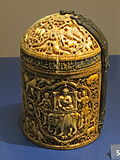|
Pyxis (vessel) A pyxis (Greek: πυξίς; pl.: pyxides) is a shape of vessel from the classical world, usually a cylindrical box with a separate lid and no handles.[1] They were used to hold cosmetics, trinkets or jewellery, but were also used for dispensing incense and by physicians to contain medicine.[2] Surviving pyxides are mostly Greek pottery, but could also be made from a range of other materials: wood, bronze, ivory, marble, terracotta, silver, or stone.[3] The name derived from Corinthian boxes made of wood from the tree puksos ("boxwood").[3] During the Classical period, the Attic word "kylichnis" was also used to refer to the same shape.[3] The shape of the vessel can be traced in pottery back to the Protogeometric period in Athens, however the Athenian pyxis has various shapes itself. TypesThere were many different varieties of pyxis, popular in different times and places. The earliest were the Protogeometric type of vessel which had a globular body, and the pointed-bottom pyxis from the early Geometric period.[4] The pointed pyxis didn't last much longer than the ninth century BCE. During the later Geometric period another style emerged with a flat, very broad base.[5] Contemporary scholarship classifies pyxides as either: type A, type B, type C, type D, lekanis, Nikosthenic, or tripod.[6] Nikosthenic type This type was introduced by Nikosthenes during the late sixth century BCE. It is characterised by a deep, calyx-shaped bowl with a flanged rim and a stemmed foot, and a domed lid.[7] The decorations on pyxides found in an Etruscan context tend towards depictions of battles and athletic contests; for pyxides found in Greek and near eastern Mediterranean settings the depictions tend to be of marriage, childbirth, or religious processions.[8] Evidence suggests that this was a popular type on the eastern Aegean island of Samos and in Etruria between 560–500 BCE.[9] Proto-Geometric type Examples of pyxide from the Proto-Geometric style of Greek pottery normally between roughly 1050 and 900 BCE[10][11] include the globular pyxis, a type of pyxis characterized with a wide, circular body and a flared lip at the top of the vessel.[12] Other forms of pyxide commonly from the early geometric period include the pointed pyxis is a type of pyxis characteried with a wide tip that thins into a point at the bottom.[12] Conrinthian type Corinthian style pyxides usually share similar traits of being less circular than traditional Greek geometric style pyxides. This can be seen in the tall convex pyxis,[12] and the 8th century straight-sided pyxis[12] Corinthian styles. Other forms of Corintian pyxyde inclue the Type II: Low Concave-sided pyxis[13] dated around the 5th and 4th centuries BC and the Type III: High Concave-sided pyxis[12] dated ca. late 7th century BC Gallery
See alsoReferences
Bibliography
Wikimedia Commons has media related to Pyxides. |








